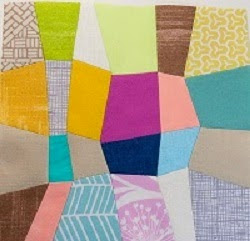Click or tap to create the 4 vertices of a quadrilateral on the canvas at the right. Then I'll do some hocus pocus and draw in some lines to create a new figure.
Press the C button above to clear the canvas, and then draw 4 more points. Try to make a really wacky quadrilateral. What's happening every time? What do you notice?
What you should see if I did everything right (and if you actually made a quadrilateral) is another quadrilateral--a green one--whose vertices are the midpoints of the quadrilateral you specified. The cool thing is that no matter what kind of wacky quadrilateral you make, my green quadrilateral will always be a parallelogram, with opposite sides parallel and congruent.
Let's Prove It

The Triangle Midsegment Theorem will save us a lot of time here. At the left, I've drawn a random quadrilateral, \(\small\mathtt{ABCD}\). When I draw diagonals \(\small\mathtt{\overline{AC}}\) and \(\small\mathtt{\overline{BD}}\), I form four large triangles: \(\small\Delta\)\(\small\mathtt{ABD}\), \(\small\Delta\)\(\small\mathtt{CBD}\), \(\small\Delta\)\(\small\mathtt{ABC}\), and \(\small\Delta \)\(\small\mathtt{ADC}\).
This makes side \(\small\mathtt{\overline{PQ}}\) a midsegment of \(\small\Delta\)\(\small\mathtt{ABD}\), side \(\small\mathtt{\overline{RS}}\) a midsegment of \(\small\Delta\)\(\small\mathtt{CBD}\), side \(\small\mathtt{\overline{QR}}\) a midsegment of \(\small\Delta\)\(\small\mathtt{ABC}\), and side \(\small\mathtt{\overline{PS}}\) a midsegment of \(\small\Delta\)\(\small\mathtt{ADC}\), because a midsegment is a segment that connects the midpoints of two sides of a triangle.
Well, since we know that (\(\small\mathtt{\overline{PQ}}\) and \(\small\mathtt{\overline{RS}}\)) are midsegments, the Triangle Midsegment Theorem tells us that they are each parallel to diagonal \(\small\mathtt{\overline{BD}}\). This means that they are parallel to each other. The Triangle Midsegment Theorem also tells us that \(\small\mathtt{\overline{PQ}}\) and \(\small\mathtt{\overline{RS}}\) are each half the length of \(\small \mathtt{\overline{BD}}\). And if they're both half the length of something, they must be congruent. So, \(\small\mathtt{\overline{PQ}}\) and \(\small \mathtt{\overline{RS}}\) are congruent and parallel.
The same reasoning we used in the previous paragraph can be applied to sides \(\small\mathtt{\overline{PS}}\) and \(\small\mathtt{\overline{QR}}\) along with diagonal \(\small\mathtt{\overline{AC}}\), demonstrating that \(\small\mathtt{\overline{PS}}\) and \(\small\mathtt{\overline{QR}}\) are parallel and congruent and proving that Quadrilateral \(\small\mathtt{PQRS}\) is a parallelogram.
Extensions

A nice thing about this strategy for the proof is that it seems to work even on "weird" quadrilaterals, where the quadrilateral formed by the midpoints crosses two sides of the original quadrilateral. In addition, this strategy can help you to also show that the resulting parallelogram always has half the area of the original quadrilateral, though this gets a little tricky with "weird" quadrilaterals.
(P.S.: Here's a Wikipedia entry on Varignon's Theorem. According to some cluelessly pretentious goober writing or working on that entry, the proof we just did above is one that "requires less mathematical aptitude" than one involving linear algebra--which is both untrue and irrelevant. I changed it to "requires less algebra," although "less arrogance" was much more tempting.)